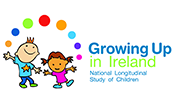
Growing Up in Ireland (GUI) — National Longitudinal Study of Children in Ireland
The Department of Children, Equality, Disability, Integration and Youth in association with the Central Statistics Office.
2006
The purpose of GUI is to study the factors that contribute to or undermine the well-being of children in contemporary Irish families; and through this, contribute to the setting of effective and responsive policies relating to children and the design of services for children and families.
Cohort ’98 (Child Cohort) is a representative sample of 9-year-olds in Ireland born between 1st November 1997 and 31st October 1998. Cohort ’08 (Infant Cohort) is a representative sample of 9-month-olds in Ireland born between 1st December 2007 and 30th June 2008.
GUI is a national longitudinal study which tracks two cohorts of children: a child cohort of 8,500 who were 9 years old when data collection began in 2007/8; and an infant cohort of 11,000, who were nine months old when data collection began in 2008/9.
The infant cohort sample was generated randomly through the child benefit register, and were interviewed when they were 9 months old (2008/2009), 3 years old (2010/2011), 5 years old (2013), 7/8 years old (2016), 9 years old (2017/2018) and 13 years old (2021/2022).
The child cohort sample was generated from a nationally representative sample of 900 schools, and were interviewed when they were 9 years old (2007/2008), 13 years old (2011/2012), 17/18 years old (2015/2016) and 20 years old (2018/2019).
Growing Up in Ireland is the national longitudinal study of children in Ireland, mainly funded by the Department of Children, Equality, Disability, Integration and Youth (DCEDIY), and managed by DCEDIY in association with the Central Statistics Office.
The key users of GUI data are students, academics, researchers, policy makers.
GUI collects data across a number of domains and themes including:
- Cognitive/educational development (e.g. cognitive/academic achievement, early childhood home learning and childcare environments, attitudes and aspirations)
- Socio-emotional development (e.g. behaviour, self-esteem, mental health and relationships)
- Health (e.g. breastfeeding, child health and health care utilisation, illness and injury, disability and long term chronic conditions, diet, BMI, physical exercise, and health behaviours).
- Economic/civic participation (from 17 years) (e.g. household characteristics, family income/work/social welfare, neighbourhood and accommodation).
Data dictionaries for each wave are available from:
https://www.ucd.ie/issda/
No national level identifier variables are included.
Equity stratifiers are included in most waves: Place of residence, Race, Occupation, Gender, Religion, Education, Socioeconomic status, Social capital
Anonymised GUI data are publicly available from two sources. An anonymised Microdata File available from https://www.ucd.ie/issda/ and a more detailed Research Microdata File available from https://www.cso.ie/en/aboutus/lgdp/csodatapolicies/dataforresearchers/rmfregister/
There have been four waves of data collection from the child cohort; at 9 years of age in 2007/8; at 13 in 2011/12; at 17/18 years old in 2015/16; and at 20 years old in 2018/19.
There have also been five waves of data collection from the infant cohort: at 9 months in 2008/9; at three years old in 2010/11; at five in 2013; at age 7/8 in 2016; and at nine in 2017/18.
We are currently (2021/2022) in the field conducting age 13 interviews.
For all waves information was collected from the child, and their parent(s)/guardian(s) and where relevant the child’s school teacher and the school principal.
Chronic illness questions are coding using ICD-10 as a guide.
The study is following almost 20,000 children. Data is not collected annually but as described above.
Technical, descriptive and thematic reports using GUI data are published on a regular basis and available on the GUI website.
The data is made available through the Irish Social Science Data Archive and the Central Statistics Office after each wave of data collection.
- The Anonymised Microdata File (AMF) is a publicly available anonymised dataset. Researchers wishing to access the AMF should apply to the Irish Social Science Data Archive (ISSDA) at www.ucd.ie/issda
- The Research Microdata File (RMF) is a more detailed dataset. Access to the RMF is project specific and subject to appointment of the researcher as an Officer of Statistics by the Central Statistics Office, meaning that the researcher is subject to the full rigour and penalties of the Statistics Act, 1993. Researchers wishing to access the RMF should apply to the Central Statistics Office. The form is available on the following link: https://www.cso.ie/en/aboutus/lgdp/csodatapolicies/dataforresearchers/rmfregister/
- GUI qualitative data for the child cohort age 9 is also a publicly available as an anonymised dataset. Researchers wishing to access the qualitative data file should apply to the Irish Qualitative Data Archive (IQDA)
No.